12
Cold Exposure, Appetite, and Energy Balance
Jacques A. LeBlanc1
INTRODUCTION
When energy intake is the same as the energy expenditure, body weight remains constant in spite of continuous body energy reserve turnover (Figure 12-1). Appetite, which plays a prominent role in this system, is itself under the influence of many internal and external factors. Situations that increase energy expenditure, such as exercise and exposure to cold, stimulate appetite and cause an enhanced energy intake. There is also some evidence indicating that the climate under which people live may also influence appetite. In a warm environment, energy intake has been shown to be curtailed not only because of reduced physical activity but also because of some influence of climate on appetite (Adolph, 1954). The common belief that appetite and energy intake are stimulated by the cold is based on experimental evidence and anecdotal hearsay. The present review will analyze the components of energy expenditure and intake in cold regions and identify various factors that may influence appetite.
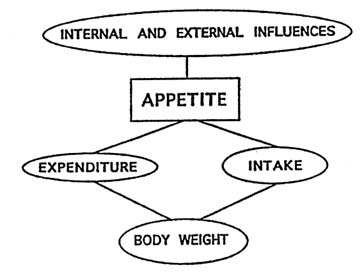
FIGURE 12-1 Schematic representation of interactions between appetite and components of energy balance. SOURCE: J. A. LeBlanc (Unpublished data, Laval University, Quebec City, 1993).
COMPONENTS OF ENERGY EXPENDITURE IN THE COLD
Basal Metabolic Rate
When the total energy expenditure for a typical subject is 2,750 kcal/d, approximately 60 percent of this total energy is due to basal metabolic rate (BMR) (1,500 kcal). Some years ago it was reported that Eskimos had higher BMR than Caucasians. It was suggested that this might be due to an increased thyroid activity induced by cold (Rodahl, 1952a, b). Subsequent work disproved this hypothesis. It was shown that the higher BMR of Eskimos was due to the high protein content of their diet. When Eskimos were made to eat a mixed diet comparable to the one consumed by Caucasian subjects, BMRs were the same for the two groups (Rodahl, 1952a, 1952b, 1955).
Thermogenic Effect of Feeding
The digestion, absorption, and storage of ingested nutrients require energy. The level of expenditure, known as the thermogenic effect of feeding (TEF), is different depending on whether carbohydrates, proteins, or lipids are consumed (Unpublished data, J. A. LeBlanc, Laval University, Quebec City, 1992) (Figure 12-2). For a comparable calorie intake, the TEF is small for fat,
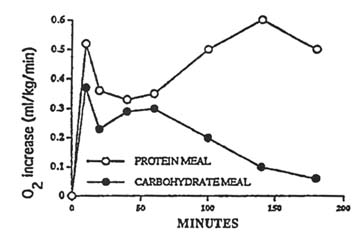
FIGURE 12-2 Thermogenic effect of feeding carbohydrate and protein meals with relation to time. SOURCE: J. A. LeBlanc (Unpublished data, Laval University, Quebec City, 1990).
intermediary for carbohydrates, and high for proteins. In addition, because of slower absorption, the TEF of proteins may last up to 5 to 6 hours (Jéquier, 1993). For that reason, if a person is to sleep in an unheated tent under arctic winter conditions, the ingestion of proteins at the end of the day may serve—because of their large and long-lasting thermogenic action—as an adjuvant in achieving thermal comfort for part of the night. In contrast, carbohydrates, by supplying energy that is quickly absorbed and readily available for various body activities, would be most useful at the beginning and middle of the day. Fat as a source of utilizable energy would be useful only in situations where there is a calorie deficit. When fed in excess, as part of a mixed diet, fat is not oxidized and is almost entirely stored in fat depots. The belief that large amounts of fat are required in the cold is not substantiated by some recent findings (Flatt et al., 1985; Schutz et al., 1989).
Thermogenic Effect of Cold
To discuss the importance of the thermogenic effect of cold (TEC) and the thermogenic effect of exercise in the cold, the results of an experiment that was undertaken quite some time ago will be used to introduce the subject (LeBlanc, 1957b). While carrying a packsack and wearing full arctic clothing, a group of soldiers took part in an 18-mi (29-km) march on a road covered with hard snow. They started in the morning as the sun was rising and finished their walk about 2 hours after sunset. During this period, the air temperature
remained around -20°C (-4°F), and the wind was low. Heart rate measurements were made throughout the expedition.
Results showed that, in spite of the fact that the rate of walking declined steadily, a gradual elevation of heart rate took place up to mile 13. After that, heart rate fell gradually and reached initial values by the end of the expedition (Figure 12-3). These variations could not be explained by external temperature, which remained constant throughout the day. The curve for solar radiation, however, followed exactly the same pattern as that of heart rate. This suggests that when the sun was out, the subjects became overheated, causing heart rate to go up. Then when the sun disappeared, they cooled down, and heart rates fell.
It was concluded that during this expedition the subjects suffered from heat, not cold, exposure even though the temperature was -20°C (-4°F). With the amount of clothing they were wearing (between 5 and 6 clo2) and at the level of activity at which they were functioning (i.e., equivalent to about three times the resting values), subjects would have been relatively comfortable at temperatures as low as -40°C (-40°F).
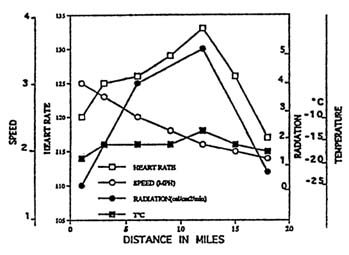
FIGURE 12-3 Heart rate variations in a group of soldiers during an 29-km (18-mi) walk in the Arctic. The outdoor temperature, solar radiation, and speed of movement of the subjects are also given.
SOURCE: LeBlanc (1957b), used with permission.
It seems then that the TEC is small in the majority of conditions. However, on occasion (i.e., accidentally or when sleep is in an unheated tent) the TEC may become an important and even threatening factor in extreme cold situations. Considering the overall effect of cold, in general the most prevailing hazardous effect of low temperatures is the danger of freezing parts of the face and extremities rather than being victim to insufficient energy production and becoming hypothermic.
Thermogenic Effect of Exercise
Oxygen consumption measurements were made over a period of 24 hours on a group of soldiers during a military exercise in the Canadian Arctic (Welch et al., 1958). For standard tasks and activities comparable to those carried out in a temperate climate, it was found that the total energy expenditure for 1 day was about 3,500 kcal, a value comparable to similar activities in warmer regions. One would expect an excess thermogenic effect on exercise (TEE) in the cold because of the hobbling effect of clothing, which has been shown to cause an increment of about 10 to 15 percent (Teitlebaum and Goldman, 1972). This effect, however, is not very important since for a person walking 15 miles (24.2 km) at an estimated cost of 100 kcal/mile (61.3 kcal/km), the extra energy required would amount to approximately 200 kcal.
Another factor that could affect the TEE is the condition of the terrain. In the Arctic, the absence of trees makes traveling much easier, and since the snow is hard, skis and toboggans can be used. Further south, because of the presence of trees, the snow is soft, and snowshoes have to be used instead of skis, which means greater energy expenditure. Thus, for given activities, the TEE in arctic regions is probably the same if not lower than that in temperate zones.
MEASUREMENTS OF CALORIE INTAKE ON ARCTIC EXPEDITIONS
The caloric content of military arctic rations is based on measurements of food intake during various expeditions. An analysis of the findings is made difficult by the fact that these expeditions were not necessarily planned for research purposes. For that reason the TEE varies a great deal, and it is never measured. The reports simply state whether exercise was light, moderate, or heavy.
Figure 12-4 summarizes the results of some of these expeditions. Rodahl (1958) estimated that Eskimos, when they hunted with dogs and lived in igloos,
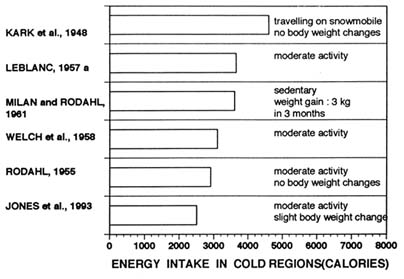
FIGURE 12-4 Energy intake reports in various arctic expeditions. For each study the method used for food consumption measurements and the level of activity are indicated.
consumed about 3,000 kcal/d. Considering the weight of these people, which would be about 60 kg, an extrapolated value for a 70-kg man would be about 3,500 kcal.
Welch et al. (1958), as mentioned above, made accurate measurements of expenditures for moderately active soldiers and arrived at a total energy expenditure of 3,300 kcal.
Milan and Rodahl (1961) measured food intake for long periods in an antarctic expedition and reported an average intake of 3,500 kcal. Because the subjects lived indoors and were sedentary, the intake was excessive and led to an increase of body weight of about 200 g/wk.
Kark et al. (1948) made some estimates of caloric intake in a joint 3-month Canadian and American expedition in the Canadian North. It was a multipurpose exercise that entailed testing equipment and machinery. Food intake was estimated for soldiers traveling most of the time by snowmobile. It was reported that 4,400 kcal/d were consumed. Because there was no body weight change during the expedition, the results suggest that the arctic ration should contain that number of calories. Considering the level of activity of these subjects and the fact that the TEC was negligible, the reported food intake would seem to be quite high. Regarding the method used for arriving at these values, ''estimates of food consumption and wastage were made from records of food supplied (21,000 calories a day for 4 men) and from dietary
histories taken from the men" (p. 74). In other words, it was left to each man to say how much he ate.
It has been argued in a recent review that this method is not always reliable and may lead to substantial errors (Schoeller et al., 1990). What may have happened is that part of the ration was thrown away, as is commonly done in the field, but it was reported as having been eaten. This suggestion is made because it is estimated, based on the studies already mentioned and considering the low level of physical activity involved in driving vehicles, that the food intake to maintain constant body weight should be about 3,000 kcal or below. This is the expenditure of a 70-kg man engaged in daily activities equivalent to about 1,000 kcal (walking 10 miles or 16 km). The daily expenditure for driving a vehicle is certainly not higher than that. This would mean that two-thirds of the ration was sufficient to maintain an equilibrated energy balance and that the other third was discarded.
A more recent study was described by Jones et al. (1993) in which questionnaires also were used to estimate food intake. Completely opposite results were obtained. During a 10-d arctic expedition, the energy intake of moderately active subjects was reported to be 2,600 kcal/d. The authors concluded that the use of questionnaires to estimate food intake is often unreliable and that it led in this specific study to underestimation of real values.
APPETITE AND BODY WEIGHT GAIN IN ARCTIC EXPEDITIONS
In the six studies mentioned in Figure 12-5, body weight was taken before and after the subjects had stayed in arctic or antarctic regions for periods of 3 to 12 months. An average body weight gain of 1 kg/month was observed in these expeditions. The excess energy intake causing this gain is explained by changes in appetite. The possible factors responsible for an enhanced appetite in cold regions include:
- palatability of food,
- cold temperature,
- season of the year,
- emotional factors (e.g., loneliness), and
- changes in physical activity habits.
Palatability of Food
The palatability of food exerts an important influence on food intake. This is illustrated by a recent report in which the subcutaneous fat layer of young
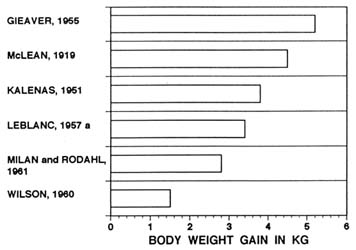
FIGURE 12-5 Body weight gain in various arctic expeditions lasting between 3 and 12 months.
Eskimos (aged 9 to 19) was shown to be twice as large in 1990 as it was in 1970 (Rode and Shephard, 1992). This difference is explained by the fact that in 1970 these youngsters were fed the traditional Eskimo diet characterized by high protein and fat content and the absence of carbohydrates, whereas in 1990 they ate typical modern western food such as sweets, popcorn, chocolate bars, ice cream, and soft drinks. It is a good example of what a "cafeteria" diet can do to humans. For Caucasian populations that move to the Arctic, it is doubtful that the food becomes more appetizing, especially if it is fed in the form of dehydrated rations.
Cold Temperature
Contrary to heat, cold exposure is generally considered as a stimulant of appetite. However, two studies—one by Lewis et al. (1960) in the Arctic and the other by Milan and Rodahl (1961) in the Antarctic—do not seem to substantiate this possibility (Figure 12-6). Both studies have shown large body weight gain between the end of the summer when subjects arrived from warmer climates and the beginning of the winter. However, during the colder months the body weight remained stable, indicating that food intake was not excessive and that appetite was not overly-stimulated. The conclusion from these studies is that cold temperature, in itself, does not have a direct influence on food intake.
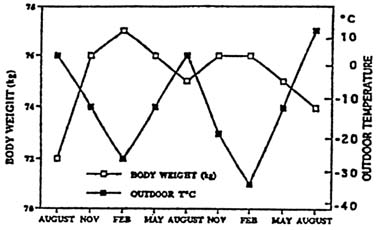
FIGURE 12-6 Body weight and outdoor temperature variations in a 2-yr expedition in North Greenland.
SOURCE: Lewis et al. (1960), used with permission.
Season of the Year
It has been reported that some people during the winter season become depressed and start eating more. This condition, described as the SAD (seasonal affective disorder) syndrome, has been related to the shortening of the days during the winter season (Rosenthal et al., 1985). Some improvement in symptoms has been reported when these persons are exposed to additional daylight. This syndrome is rather rare in a large population, and for that reason it is not likely to explain the increase in body weight commonly observed in large groups of people spending the winter in cold regions as described above.
Emotional Factors
When soldiers are transferred from a southern region to the Arctic to spend the winter, they are suddenly exposed to an unusual environment. Away from friends and family, they are confined to restricted quarters with persons that they do not know. Having few activities besides their work, they may get lonely and bored and may eventually develop a tendency to overeat.
Physical Activity
Changes in physical activity habits may also be related to the excess energy intake reported in cold regions. It is common to observe a rapid weight
gain in athletes, or in people engaged in a sustained physical activity program, when they suddenly become sedentary (Marti and Howald, 1990). This happens because the energy intake remains elevated for some time even if the expenditure is reduced. The reciprocal situation is observed when sedentary people engage in regular physical activities. At first a rather accelerated weight loss is often described, which may be due to the fact that energy intake increases immediately to meet the new requirements. In other words it takes time for the appetite to adjust to the changes in energy expenditure. This situation applies to people who move from southern regions at the end of the summer, where they were engaged in various physical activities, to northern regions, where they become more sedentary. Following the same reasoning, when these same people become more active the following summer, they should lose weight and return to their previous level.
The increase in body weight observed in cold regions has been observed in many groups of people. Apparently, it is a normal psychophysiological response to a specific environment. It is comparable to what happens in nature in the fall when wild animals start eating more in order to accumulate body fat reserves as a source of energy and additional insulation for the winter. The mechanism involved for humans, however, may not necessarily be comparable in nature.
AUTHOR'S CONCLUSIONS
The possibility of frostbite and hypothermia are always present in cold regions. For these reasons it is important to be completely familiar with the various parts of the clothing and to pay special attention to the protection of the face and the extremities. On the other hand, perspiration should be avoided whenever possible in a cold environment. The sweat, which accumulates in garments without proper ventilation while exercising, may ice up when the soldier becomes inactive, a process that may significantly reduce the insulating properties of the clothing. In addition, it is also important to have an adequate supply of food as palatable as possible in order to maintain a positive energy balance and good morale.
With proper clothing, the effect of cold, per se, on caloric requirements and appetite does not seem to be very important.
The thermic effect of exercise seems to be somewhat higher in colder regions due to the hobbling effect of clothing. Upon arrival in the Arctic and Antarctic a person's appetite is stimulated, resulting in enhanced caloric intake and body weight gain. The reduction of physical activity, the diminution of daylight, and some emotional factors may explain the stimulation of appetite. Further work is needed, however, to evaluate these possibilities adequately.
REFERENCES
Adolph, E.F. 1954 Water metabolism in hot climates. Pp. 54–62 in Nutrition Under Climatic Stress, H. Spector and M.S. Peterson, eds. A report of the Committee on Foods, Advisory Board on Quartermasters Research and Development. Washington, D.C.: National Academy of Sciences/National Research Council.
Flatt, J.P., E. Ravussin, K.J. Acheson, and E. Jéquier 1985 Effects of dietary fat on postprandial substrate oxidation and on carbohydrate and fat balances. J. Clin. Invest. 76:1019–1024.
Giaever, J. 1955 The White Desert. The Official Account of the Norwegian-British-Swedish Antarctic Expedition. New York: Dutton and Co., Inc.
Jéquier, E. 1993 Body weight regulation in humans: The importance of nutrient balance. News in Physiological Sciences 8:273–277.
Jones, P.J.H., I. Jacobs, A. Morris, and M.B. Ducharme 1993 Adequacy of food rations in soldiers during an arctic exercise measured by doubly labeled water. J. Appl. Physiol. 75:1790–1797.
Kalnenas, K. 1951 Notes on the food rations of the Macquarie Island Antarctic Expedition. Report no. CM 14 (14/50/786/641-1). Melbourne: Australian National Antarctic Research.
Kark, R.M., R.R.M. Croome, J. Cawthorpe, D.M. Bell, A. Bryans, and R.J. MacBeth 1948 Observations on a mobile arctic force. J. Appl. Physiol. 1:73–93.
LeBlanc, J. 1957a Effect of environmental temperature on energy expenditure and calorie requirements. J. Appl. Physiol. 10:281–283.
1957b Use of heart rate as an index of work output. J. Appl. Physiol. 10:275–280.
Lewis, H.E., J.P. Masterton, and S. Rosenbaum 1960 Body weight and skinfold thickness of men on a polar expedition. Clin. Sci. 19:551–562.
Marti, B., and H. Howald 1990 Long-term effects of physical training on aerobic capacity. J. Appl. Physiol. 69:1451–1459.
McLean, A.L. 1919 Bacteriological and other researches. Australian Antarctic Expedition scientific reports, series C, part 4. 7:100.
Milan, F.A., and K. Rodahl 1961 Calorie requirements of man the in Antarctic. J. Nutr. 75:152–157.
Rodahl, K. 1952a Basal metabolism of the Eskimo. Pp. 1–110 in Arctic Aeromedical Laboratory project no. 22-1301-001, part 2. Ft. Wainwright, Alaska: Arctic Aeromedical Laboratory.
1952b Basal metabolism of the Eskimo. J. Nutr. 48:359–365.
1955 Nutritional requirements of troops stationed in Alaska. Arctic Aeromedical Laboratory project no. 7-7954, no 1. Ft. Wainwright, Alaska: Arctic Aeromedical Laboratory.
1958 Human acclimatization to cold. Pp. 177–248 in Cold Injury, I. Ferrer, ed. New York: Josiah Macy Jr. Foundation.
Rode, A., and R.J. Shephard 1992 Fitness and health of an Inuit community: 20 years of cultural changes. Circumpolar and Scientific Affairs. Ottawa: Ministry of Indian and Northern Affairs.
Rosenthal, N.E., D.A. Sack, B.L. Parry, C.J. Carpenter, W.B. Mendelson, and T.A. Wehr 1985 Antipressant effects of light in seasonal affective disorder. Am. J. Psychiat. 142:606–608.
Schoeller, D.A., L.G. Bondinin, and W.H. Dietz 1990 Inaccuracies of self-reported intake identified by comparison with the doubly labeled water method. Can. J. Physiol. Pharmacol. 68:941–949.
Schutz, Y., J.P. Flatt, and E. Jéquier 1989 Failure of dietary fat intake to promote fat oxidation: A factor favoring the development of obesity. Am. J. Clin. Nutr. 50:307–314.
Teitlebaum, A., and R.F. Goldman 1972 Increased energy cost with multiple clothing layers. J. Appl. Physiol. 32:743–744.
Welch, B.E., E.R. Buskirk, and P.F. Iampetro 1958 Relation of climate and temperature to food and water intake in man. Metabolism 7:141–146.
Wilson, O. 1960 Changes in body-weight of men in the Antarctic. Br. J. Nutr. 14:391–402.












